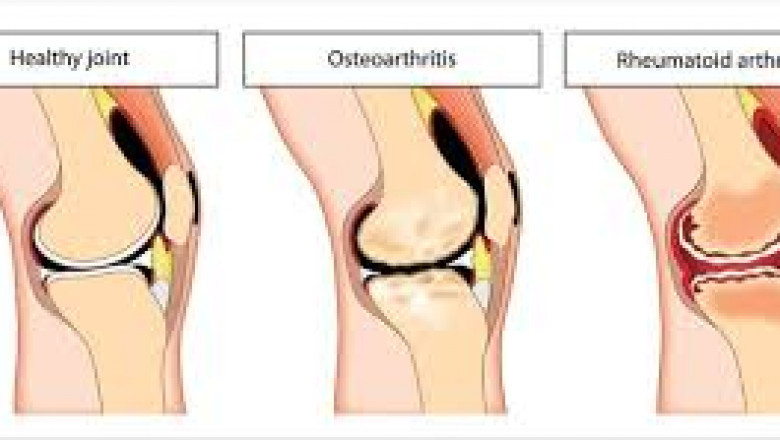views
Arthritis is a common condition that affects millions of people worldwide, but not all types of arthritis are the same. Two of the most common forms are Osteoarthritis (OA) and Rheumatoid Arthritis (RA). While both cause joint pain, stiffness, and swelling, they have different causes, risk factors, and treatments.
In the quest for optimal health, advancements in pharmaceuticals continue to provide us with innovative solutions. One such breakthrough is Carticlas tablets, a remarkable supplement designed to support and enhance overall health. This article delves into the benefits, mechanisms, usage, and future potential of Carticlas tablets, providing a comprehensive understanding of how they can help you achieve your health goals.
In this blog, we’ll explore the key differences between OA and RA, their causes, symptoms, and treatment options, and how you can manage them effectively.
What Is Osteoarthritis (OA)?
Definition:
Osteoarthritis is a degenerative joint disease that occurs when the cartilage (the cushion between bones) wears down over time. This leads to pain, stiffness, and reduced mobility. It’s often called the “wear and tear” arthritis because it develops gradually due to aging and overuse of joints.
Causes of OA:
✔ Aging (most common in people over 50)
✔ Repetitive joint use (e.g., in athletes or physical laborers)
✔ Joint injuries or trauma
✔ Obesity (extra weight puts stress on joints)
✔ Genetic factors
Symptoms of OA:
✅ Gradual onset of joint pain (worse after activity)
✅ Morning stiffness (lasting less than 30 minutes)
✅ Joint swelling and tenderness
✅ Bone spurs (extra bone growth causing pain)
✅ Cracking or grinding sound when moving the joint
Commonly Affected Joints:
🦵 Knees
🖐 Hands
🦶 Hips
🦶 Spine
What Is Rheumatoid Arthritis (RA)?
Definition:
Rheumatoid arthritis is an autoimmune disease where the body’s immune system mistakenly attacks the joints, causing inflammation, pain, and joint damage. Unlike OA, which occurs due to wear and tear, RA is an immune system malfunction that leads to chronic inflammation.
Causes of RA:
✔ Autoimmune response (body attacks healthy joint tissues)
✔ Genetic factors (family history of RA increases risk)
✔ Environmental triggers (smoking, infections, or stress)
✔ Hormonal factors (more common in women)
Symptoms of RA:
✅ Symmetrical joint pain (affects both sides of the body)
✅ Morning stiffness lasting more than 1 hour
✅ Swollen, warm, and red joints
✅ Fatigue and general body weakness
✅ Fever and weight loss (in some cases)
Commonly Affected Joints:
🖐 Hands
🦶 Wrists
🦵 Knees
🦶 Feet
💪 Elbows
Key Differences Between OA and RA
| Feature | Osteoarthritis (OA) | Rheumatoid Arthritis (RA) |
|---|---|---|
| Cause | Wear and tear of cartilage | Autoimmune attack on joints |
| Onset | Develops slowly over years | Can develop quickly within weeks or months |
| Pain Timing | Worsens with activity, better with rest | Worse in the morning, improves with movement |
| Inflammation | Mild swelling, occasional flare-ups | Persistent inflammation, swollen joints |
| Affected Joints | Hips, knees, spine, hands | Hands, wrists, feet, knees |
| Symmetry | Usually affects one side first | Affects both sides equally |
| Whole-Body Symptoms | No systemic effects | Fatigue, fever, and weight loss |
Treatment Options for OA and RA
Managing Osteoarthritis (OA):
Since OA is caused by joint wear and tear, treatment focuses on reducing pain, improving mobility, and protecting the joints.
✅ Pain Relief Medications: Acetaminophen, NSAIDs (ibuprofen, naproxen)
✅ Weight Management: Reducing excess weight relieves joint pressure
✅ Physical Therapy & Exercise: Strengthens muscles around joints
✅ Joint Supplements: Glucosamine & chondroitin may support cartilage health
✅ Hot & Cold Therapy: Ice packs reduce swelling, heat improves stiffness
✅ Surgery (Severe Cases): Joint replacement (hip or knee) may be needed
Managing Rheumatoid Arthritis (RA):
RA requires treatment to control the immune system response and prevent joint damage.
✅ Disease-Modifying Anti-Rheumatic Drugs (DMARDs): Slow disease progression (e.g., Methotrexate, Sulfasalazine)
✅ Biologic Medications: Target specific immune responses (e.g., Humira, Enbrel)
✅ Steroids & NSAIDs: Reduce inflammation and pain
✅ Regular Exercise & Physical Therapy: Helps maintain joint flexibility
✅ Lifestyle Changes: Stress management, anti-inflammatory diet
✅ Surgery (Severe Cases): Joint reconstruction in advanced RA
Lifestyle Tips for Both OA & RA
✔ Eat an Anti-Inflammatory Diet (fruits, vegetables, omega-3 fatty acids)
✔ Stay Active with Low-Impact Exercises (swimming, yoga, walking)
✔ Use Joint Protection Techniques (avoid repetitive movements, use supportive footwear)
✔ Manage Stress & Get Enough Sleep (reduces flare-ups)
✔ Quit Smoking & Reduce Alcohol Consumption (benefits RA management)
Final Thoughts: Living Well with Arthritis
Both Osteoarthritis (OA) and Rheumatoid Arthritis (RA) can cause joint pain and stiffness, but they have different causes, progression, and treatments.
-
OA is a degenerative disease caused by joint wear and tear, typically managed with pain relief, weight control, and physical therapy.
-
RA is an autoimmune disease that requires immune-modulating treatments, lifestyle changes, and long-term management.
If you’re experiencing joint pain or stiffness, consult a doctor to determine which type of arthritis you have and create a personalized treatment plan. By making healthy lifestyle changes and following the right treatments, you can reduce symptoms and improve your quality of life!






















Comments
0 comment